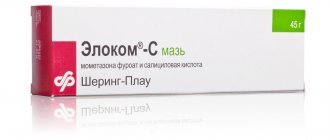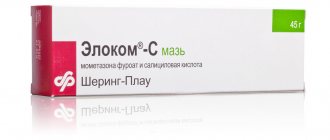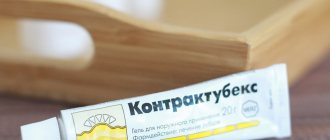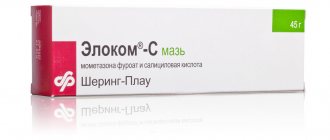Composition and dosage forms
The active component of the drug Elocom is the substance mometasone, a hormone that suppresses the production of inflammatory mediators. Available in the following forms:
- Cream: a homogeneous white substance with a slightly oily texture with a barely perceptible ether smell, packaged in 15 ml aluminum tubes. Auxiliary components of the drug: petroleum jelly, water, titanium dioxide, phosphoric acid, wax, stearyl alcohol and others.
- Elokom ointment: viscous yellowish mass in 15-gram metal tubes.
- Lotion: a transparent liquid on a water-alcohol basis, sold in 20 ml bottles equipped with dropper dispensers. Lotion stabilizing agents: propylene glycol, sodium phosphate.
All forms of the drug have a general purpose, have an anti-inflammatory effect, reduce itching, redness and swelling of the skin in dermatological diseases.
Overdose
Excessive and long-term use of local corticosteroids can cause inhibition of the function of the pituitary-adrenal system, which can cause the development of secondary adrenal insufficiency, which is usually reversible.
If this system is suppressed, the interval between applications should be increased or GCS with less activity should be used or the drug should be discontinued.
The steroid content of each container is so low that in the unlikely event of accidental ingestion, there will be little or no toxic effect.
Mechanism of action of the drug Elokom
Mometasone as part of the medication slows down the release of arachidonic acid in the body, the main precursor of mediators of inflammatory reactions. Penetrating through the skin, Elokom stimulates the production of special proteins in the blood - lipocortins. They block the action of phospholipase, an enzyme responsible for the inflammatory response of tissues. As a result of use, irritation and accumulation of exudate are reduced.
Part of the applied product is absorbed into the bloodstream. With a single use, about 0.5% of the active substance penetrates into the body, the rest is concentrated directly at the site of inflammation of the skin. With regular use, the content of glucocorticoid hormone in the cells increases. Microdamages in the affected areas promote drug absorption. This is important to consider during treatment. With prolonged exposure to the body, mometasone can cause hormonal imbalances.
pharmachologic effect
Pharmacological action - antiexudative, antipruritic, anti-inflammatory.
The mechanism of action appears to involve inducing the release of proteins that inhibit phospholipase A2 and are collectively known as lipocortins. These proteins are thought to control the biosynthesis of potent inflammatory mediators such as PG and LT by inhibiting the release of their common precursor, arachidonic acid.
Carcinogenesis, mutagenesis. Genetic toxicity studies of mometasone furoate, including the Ames test, the murine lymphoma test, and the micronucleus test, showed no evidence of mutagenicity.
Long-term animal experiments aimed at assessing the carcinogenic effect of the drug have not been conducted.
Contraindications
The medicine should not be used to get rid of diaper dermatitis and other skin irritations in infants. Other contraindications include:
- allergic reactions to the components of the drug;
- open injuries: bleeding scratches, abrasions, wounds;
- neoplasms at the sites of application of the product: moles, papillomas;
- diagnosed insufficiency of the adrenal glands, hypothalamus and pituitary gland.
Elokom should not be applied to sensitive skin of the face, groin area, or axillary areas.
The drug is prescribed to pregnant women with caution in emergency cases: with intense acute symptoms of dermatoses, when the benefit to the mother outweighs the likely risk to the health of the fetus. There is insufficient information about the effect of Elokom on intrauterine development, but no cases of teratogenic effect have been recorded.
Elokom, 0.1%, cream for external use, 15 g, 1 pc.
Elokom cream, ointment, lotion are indicated only for dermatological use and are not intended for use in ophthalmology.
As a result of systemic absorption with local use of various glucocorticosteroid drugs, reversible suppression of the function of the hypothalamic-pituitary-adrenal system, as well as symptoms of glucocorticosteroid insufficiency after discontinuation of the drug, may occur. In patients, as a result of systemic absorption of glucocorticosteroids during systemic use, Cushing's syndrome, hyperglycemia and glycosuria may also develop.
Patients receiving topical corticosteroids for the treatment of large areas of skin or under occlusive dressings should be periodically monitored for signs of suppression of the hypothalamic-pituitary-adrenal axis. This can be done by performing an ACTH stimulation test, measuring morning cortisol in plasma and in media other than urine. If suppression of the hypothalamic-pituitary-adrenal system is noted, the interval between applications should be increased, or another less potent glucocorticosteroid should be used, or the drug should be discontinued. Restoration of the function of the hypothalamic-pituitary-adrenal system usually occurs soon after discontinuation of local glucocorticosteroids. Sometimes signs and symptoms of glucocorticosteroid deficiency may appear, which requires additional use of systemic glucocorticosteroids, a description of which can be found in the annotations for such drugs.
The drug Elokom can be used in children from 2 years of age, however, it should be borne in mind that the safety and effectiveness of its use in children for a period exceeding 3 weeks have not been studied.
Due to the fact that children have a larger surface area to body weight ratio than adults, children are at greater risk of suppressing the function of the hypothalamic-pituitary-adrenal axis and the occurrence of Cushing's syndrome when using any topical glucocorticosteroid drugs. For the same reason, children have a higher risk of adrenal insufficiency when treatment with topical glucocorticosteroids is discontinued. When treated with local glucocorticosteroids in children, atrophic changes in the skin occur more easily, up to the appearance of atrophic stripes. The risk of suppression of the hypothalamic-pituitary-adrenal system in children increases when glucocorticosteroids are applied to an area of more than 20% of the body surface.
There are reports of suppression of the function of the hypothalamic-pituitary-adrenal system, the appearance of Cushing's syndrome, growth retardation, delayed weight gain and intracranial hypertension in children with topical use of various glucocorticosteroid drugs. Manifestations of adrenal insufficiency include low plasma cortisol and lack of response to ACTH stimulation. Intracranial hypertension leads to bulging fontanelles, headache, and bilateral papilledema.
Elokom ointment and cream should not be used to treat dermatitis caused by wearing diapers.
Ointment, cream and lotion should not be used under occlusive dressings unless prescribed by a doctor. Ointment and cream should not be applied to children on areas of skin that are under diapers or under waterproof underpants (occlusive dressing effect). The ointment and cream are not intended for use on the face or in the groin and armpit areas.
If irritation occurs, use of Elokom should be discontinued and appropriate treatment prescribed. Allergic contact dermatitis with corticosteroids is usually diagnosed by evidence of treatment failure, which should be confirmed by skin testing.
If a concomitant skin infection develops, an appropriate antifungal or antibacterial agent should be used. If a positive response to treatment is not achieved quickly, use of the drug should be suspended until the infection is eliminated.
As with other glucocorticosteroids, use of Elokom cream, ointment and lotion should be discontinued once cured. If there is no improvement within 2 weeks after starting therapy, the diagnosis may need to be clarified.
How to use Elokom: instructions
Cream, ointment or lotion must be applied directly to the lesions, after washing and drying the skin:
- 0.5–1 ml per dose: a few drops, gently rubbing the drug until completely absorbed;
- after using the ointment as prescribed by the doctor, cover the painful areas with a vapor-permeable bandage;
- The procedure is repeated daily until the symptoms of the disease disappear.
The course of therapy is about 2 weeks. The maximum duration of use of the product is 3 weeks. If there is no result, the medication should be discontinued and additional examination should be performed.
If an infection is detected in the affected area, hormonal therapy is interrupted and antibiotics or fungicidal drugs are prescribed. If necessary, Elokom can be used after suppression of the pathogen.
Directions for use and doses
Locally.
Elokom®
Apply a thin layer of cream or ointment to the affected areas of the skin once a day.
Lotion - apply a few drops to the affected areas of the skin once a day; After application, the lotion is rubbed in with gentle movements until it disappears from the surface of the skin. For the most effective and economical use of the drug, it is necessary to bring the spout of the bottle closer to the affected area of the skin and lightly squeeze the bottle.
Elocom® Lotion
Lotion - apply a few drops to the affected areas of the skin once a day; After application, the lotion is rubbed in with gentle movements until it disappears from the surface of the skin. For the most effective and economical use of the drug, it is necessary to bring the spout of the bottle closer to the affected area of the skin and lightly squeeze the bottle.
The duration of treatment is determined by its effectiveness, as well as patient tolerability, the presence and severity of side effects.
Side effects of the drug
Elokom is tolerated well in most cases, without causing significant negative effects on the skin. Sometimes in the first days of use, a slight burning sensation appears immediately or some time after application. In some cases, itching and redness may increase. Other possible effects:
- development of boils;
- acne, folliculitis.
If burning and itching progresses, you should suspect increased individual sensitivity and consult a doctor about changing the drug.
With long-term treatment, the risk of bacterial or fungal infection, demodicosis, increases. Increasing the dosage of the drug leads to the accumulation of mometasone in the blood. This can provoke a decrease in the functions of the adrenal glands and pituitary gland. The production of your own glucocorticoids decreases. After stopping the course of therapy, this is fraught with systemic hormonal disruptions. Proper use of the drug rarely leads to endocrine changes.
Pharmacokinetics
The extent to which topical glucocorticosteroids penetrate the skin depends on many factors, including the composition of the drug and the integrity of the epidermal barrier. Inflammation and other processes occurring in the skin can lead to increased penetration of the drug through the skin. With a single local application to intact skin (without an occlusive dressing), approximately 0.7% of the ointment dose and approximately 0.4% of the cream are detected in the blood after 8 hours. There is reason to believe that the level of absorption of the glucocorticosteroid in the dosage form of the lotion is also insignificant.
Note!
The description of the drug Elokom ointment 0.1% tube 30g on this page is a simplified author’s version of the apteka911 website, created on the basis of the instructions for use.
Before purchasing or using the drug, you should consult your doctor and read the manufacturer's original instructions (attached to each package of the drug). Information about the drug is provided for informational purposes only and should not be used as a guide to self-medication. Only a doctor can decide to prescribe the drug, as well as determine the dose and methods of its use.



